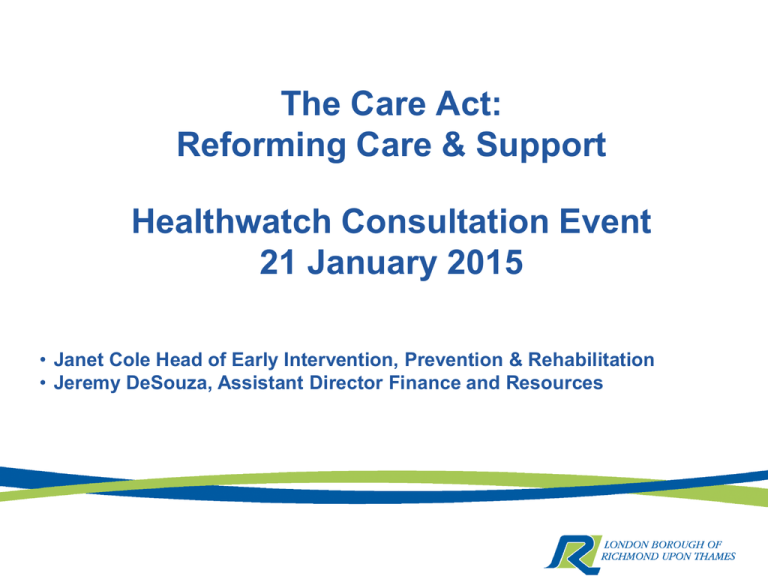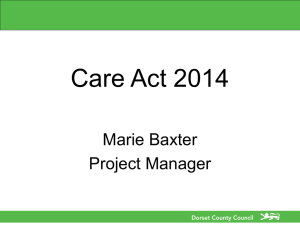the event presentation
advertisement

The Care Act: Reforming Care & Support Healthwatch Consultation Event 21 January 2015 • Janet Cole Head of Early Intervention, Prevention & Rehabilitation • Jeremy DeSouza, Assistant Director Finance and Resources What is the Care Act? “reforms mark a generational shift in our system of care, a shift from a system that is essentially paternal, reactive and prescribed to one that is preventative, personalised and proactive in its care approach. A system that focuses on people's strengths, that seeks to secure personal wellbeing replacing one that focuses on deficits and meeting need.” Jon Rouse Director General for Social Care, Dept. of Health, May 2014 What is the Care Act? • Biggest change in Adult Social Care legislation for over 60 years: • Based on principle of wellbeing • Encompasses whole population • The Act is a platform for the next few decades albeit in tough times Summary of Care Act Duties Key requirements Timing Duties on prevention and wellbeing From April 2015 Duties on information & advice (inc paying for care) Duty on market shaping Assessments (including carers’ assessments) National minimum threshold for eligibility Personal budgets and care and support plans Safeguarding Universal deferred payment agreements Extended means test Care accounts Capped charging system From April 2016 Care Act - Timeframes Phase One: Draft Guidance/Regulations published May 2014 and consulted on throughout summer Final Guidance/Regulations issued end October 2014 Implementation commences April 2014 Phase Two Draft Guidelines to be issued January 2015 for 12 week consultation Final guidance/regulations October 2015. Autumn 2015 existing service users assessed for Care Accounts April 2015 full implementation Prevention Strategy Janet Cole Head of Early Intervention, Prevention and Reablement Introduction What the Care Act says about prevention Current preventative services Scope of the strategy Approach to developing the local strategy Approach to engagement What the strategy is aiming to achieve Care Act - Three levels of prevention Prevent (Primary Prevention) • Aimed at individuals who have no current particular health or care and support needs • These services may help an individual avoid developing needs for care and support, or help a carer avoid developing support needs by maintaining independence and good health and promoting wellbeing • E.g. LiveWell Richmond, NHS Health Checks Reduce (Secondary Prevention) • More targeted interventions aimed at individuals who have an increased risk of developing needs • The provision of services, resources or facilities may help slow down any further deterioration or prevent other needs from developing • E.g. Telecare, Falls Prevention Service Delay (Tertiary Prevention) • Interventions are aimed at minimising the effect of disability or deterioration for people with established health conditions, complex care and support needs or caring responsibilities • This includes supporting people to regain skills and reduce need where possible • E.g. Reablement, Rehabilitation Current services in Public Health & Social Care Public Health Primary Prevention services: Livewell, Stop Smoking, NHS Health Checks, Winter warming Social Care Wide range of services across all levels of prevention e.g. Rehabilitation, Falls, Equipment, Information and Advice, Home Maintenance. Many joint funded with CCG Wide and comprehensive offer compares favourably to other councils. However services developed incrementally over time; some in place for a long period. Must now assess whether these services meet the needs of the resident population Scope of the Prevention Strategy Borough wide strategy with health, social care, other council departments and community representatives Preventative services to meet resident’s identified needs within existing resources. Includes information & advice services Partnership approach and a wider offer - not just health and social care Prevention services targeted for different groups Impact and outcomes long term Approach to developing the strategy Multi agency steering group Needs analysis and service mapping Identify best practices & innovation Identify gaps Consultation Recommendations on services that need reshaping or commissioning Strategy completed spring 2015 Engagement Two workstreams have been developed to cover residents’ varying adult social care needs Prevention Strategy Engagement Target Audience: All residents over 18 Online survey https://consultation.richmond.gov.uk/ acs/prevention Covers the different ways people help to keep themselves healthy and well, which services people currently use to do this and how these can be improved Care Act Survey: Prevention, Information and Advice Target Audience: Adults with care and support needs and their carers Partner organisations have distributed the link to the online survey Focus groups arranged for January and February to gather more detailed feedback Covers the types of services, information and advice available and the ways these can be improved. Explores the use of new technologies to achieve this What the Strategy is aiming to achieve Shift in approach for: • 1) the public (doing more for themselves); • 2) professionals (making every contact count). Key cultural change Resource Directory Council & CCG reshaping re-commissioning current services to meet need – wider determinants of health, education, housing, employment, environment, etc. New technologies to replace or complement existing services Promote & provide tools for self care Questions about Prevention Social Care Charging Jeremy DeSouza Assistant Director – Finance and Resources Changes to Social Care Charges Key requirements Timing Duties on information & advice re paying for care From April 2015 New charging framework in line with national eligibility for service users/carers Universal deferred payment agreements Entitlement for self-funders to ask Council to arrange their care Extended means test – more people to access state From April funded support (capital limit increased to £118,000 from 2016 £23,250 for care homes) Lifetime cap on care costs introduced (£72,000) Care Accounts – to track progress towards the cap on care costs Universal Deferred Payments Prevents people from having to sell their home in their lifetime to fund their care (in a care home) Allows payments to be made after the service user’s death when the property is sold Must be made available to all home owners receiving care in a care home Interest charges will apply Costs of setting up/monitoring the agreement to be recovered from service users Universal Deferred Payments Administration fee of £2,500 paid upfront or added to the loan Interest rate - max rate set by DH (currently 2.65%) – updated twice yearly Interest charges compound basis - added every six months Debt secured by first charge on the property Equity Limit is 90% of property value less £14,250 (e.g. Property worth £500,000 Equity Limit is £450,000 – 14,250 = £435,750 Criteria for Deferred Payment Someone with eligible care needs requiring care in a care home Someone with less than £23,250 in savings/ other nonproperty assets Someone whose property is taken into account in their financial assessment i.e. home not occupied by spouse or dependent relative Case Study Joan needs residential care @£670pw and has savings of £15,000 and house worth £300,000 Joan has to pay for her care as assets above £23,250, but only has £15,000 easily accessible in savings Joan enters into a Deferred Payment agreement with the Council and agrees to charge on her property The Council pays the care home fees £670 pw Joan makes a contribution of £86 pw from her income and defers £584 pw Case Study continued After 1 year Joan sells her house with her family’s help Joan repays the Council £33,311 which includes interest of £443, admin fee of £2,500 and care home fees of £30,368 The overall cost to Joan is £2,463 more than the current scheme (due to the admin fee and interest) Joan chose to retain the maximum disposable income allowance of £144 pw from her income – she may have chosen to retain less disposable income and reduce the amount deferred. Joan could have rented out her property, providing additional funding towards her care home fees. Implementation Issues Ensuring quality information and advice Ensuring the scheme is accessible Encouraging homes to remain in use Facilitating support to families with property rental arrangements Protecting the public purse/ensuring recovery of deferred payment loans Self Funders Can now request Council to arrange their care at home (criteria - eligible care needs & savings above £35,000) Does not apply to care in a care home (expected to be introduced in 2016) Does not apply where someone cannot make own arrangements; Council must arrange care and not charge Charges can be made to cover costs (i.e. brokerage administration, contract monitoring, quality assurance, invoicing and debt recovery) Proposal that charges will fully recover costs of making arrangements, so this change will be cost neutral to the Council Implementation Issues Ensuring the Council’s resources are targeted at those with the most need Encouraging self-funders to make their own arrangements where it is practical to do so Supporting local providers who may wish to provide this service Providing information about local care provision so that self-funders have the right information to arrange their own care Case Study Anne is aged 80 and needs some support to live at home and is able to make her own care arrangements through a local care provider and also has a son living nearby who is willing to help with this. Her savings are £70,000. Anne asks the Council to arrange her care. The weekly cost of her care is £260 and the fee for arranging her care is £50pw. Alternatively Anne can receive information and advice from the Council and voluntary organisations about her care and either make her own arrangements or through an organisation such as RUILS, which would charge a fee. Consultation This event forms part of our consultation process on proposals for April 2015 regarding services for selffunders Consultation will be open to residents and local organisations via the Council’s website Purpose of today to seek views and develop practical solutions to address any implementation issues identified Questions about Social Care Charges










